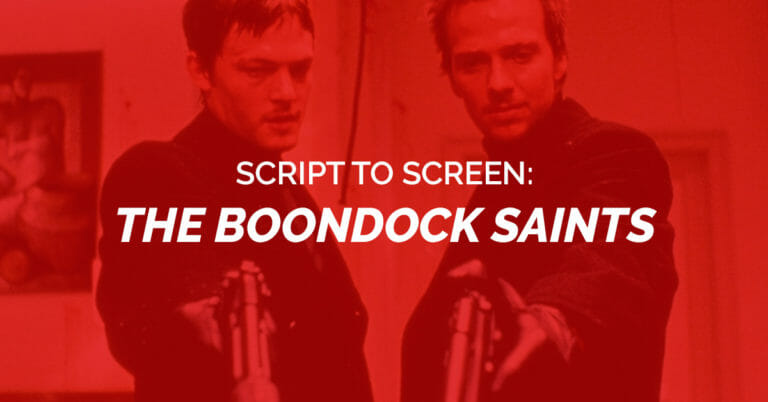By Jeff Legge · April 29, 2018

Despite a troubled production mired by studio politics, poor reviews and a limited theatrical release, The Boondock Saints has become a mainstay of cult cinema, cultivating an unlikely fan base, along with an even unlikelier sequel.
Joining the ranks of films like The Evil Dead, The Big Lebowski and The Rocky Horror Picture Show, Troy Duffy’s tale of two Irish twins thrust into a web of violence is the definition of an acquired taste – the kind of flick that prompts extreme reactions on both sides of the spectrum. But despite the fact that critics largely dismissed The Boondock Saints as a low-rent Tarantino wannabe, the film’s relatable, everyman protagonists combined with Troy Duffy’s surprisingly well-crafted screenplay ensured the film found its audience.
Before we delve further into how exactly Duffy and his team managed to pull off such an unlikely feat, let’s see what we can learn from one of the film’s more finely crafted sequences:
An oft-neglected tool in every screenwriter’s arsenal is the fundamental law of preparation and aftermath. In other words, showing the before and after of an important sequence.
Think about it – the most memorable set pieces in cinema rarely come out of nowhere. They’re built up beat-for-beat, with multiple scenes of set-up used to generate anticipation and suspense in an audience. The lobby sequence in The Matrix, for example, which is preceded by the two central heroes arming themselves to the teeth in an endless hallway of guns and ammunition.
But even more importantly, effective scenes of preparation perform an essential expository function – clarifying the emotional and physical stakes and establishing a “plan” or course of action to be followed by the protagonist. This function allows the audience to maintain their immersion and involvement in the script without ever feeling out of the loop.
This particular scene from The Boondock Saints is pure setup – a tongue and cheek sequence that sees Connor and Murphy imitating their favorite movie protagonists just prior to embarking on their quest for vigilante justice.
Not only does the array of guns on display build anticipation for the violence to follow, it also gives the audience some idea of how exactly the twins intend to rid Boston’s streets of criminals. Moreover, it also functions as a key beat along Connor and Murphy’s character arc, showing their transition from passive to active protagonists.
On the other side of preparation is aftermath – because it’s not enough to simply set up a set piece and allow it to play out. A strong script lingers on the “after”, allowing an audience to absorb all that has changed – regardless of whether those changes are good or bad for our heroes. And in the case of The Boondock Saints, what follows from this particular sequence (the slaying of 9 Russian mobsters) forms the basis for the entire latter half of the film.

Every great story gives us someone worth rooting for – at least on some level. Even the most devious, unlikeable antiheroes, for example, tend to evoke an audience’s empathy in one way or another. Breaking Bad’s Walter White rise from science teacher to drug kingpin began with the noblest of goals. Nightcrawler’s Louis Bloom was a sociopath, sure – but he was also a hard worker in an increasingly desperate economic climate.
Fitting your choice of hero to your story is essential to the overall success of your screenplay. For The Boondock Saints, Troy Duffy wisely chose to construct his somewhat self-aware tale of violence and vigilantism around two regular joes – men not unlike the film’s target audience. We first encounter Connor and Murphy celebrating St. Patrick’s Day in a pub, before a string of violent coincidences thrusts them into an action movie extravaganza.
The unlikely nature of Connor and Murphy makes them relatable to an audience – they’re “everyman” quality makes them easy to project on to, which adds to the level of audience immersion. Take the sequence from this week’s breakdown – taken on its own merits, there’s nothing particularly unique about a scene in which the heroes arm themselves for the trials to follow. What makes this particular sequence stand out is the fact that Connor and Murphy clash with their circumstances.
They’re not suave, experienced professionals – on the contrary, they’re average in just about every conceivable way. Much like the rest of us, their point of reference for a shootout isn’t their expert military training, it’s Sylvester Stallone and Arnold Schwarzenegger. This level of relatability makes the duo unique among protagonists, and it explains much of what continues to make the film so endearing to audiences.

For all its violence and flair, The Boondock Saints plays it surprisingly straight when it comes to adhering to the fundamental of solid, screenwriting craftsmanship. The result is a strong platform for all the bloody tricks up Troy Duffy’s sleeve.
 Frustrated by the dark, frozen winters of Canada, Jeff Legge spent his earliest years indoors nurturing a life-long obsession with the movies. Later, he moved to Los Angeles where he cut his teeth as a script reader while completing an MFA at the University of Southern California’s School of Cinematic Arts. He does not recommend playing Scene-It with him, though he does appreciate a good ego boost.
Frustrated by the dark, frozen winters of Canada, Jeff Legge spent his earliest years indoors nurturing a life-long obsession with the movies. Later, he moved to Los Angeles where he cut his teeth as a script reader while completing an MFA at the University of Southern California’s School of Cinematic Arts. He does not recommend playing Scene-It with him, though he does appreciate a good ego boost.
For all the latest from The Script Lab, be sure to follow us on Twitter, Facebook, and Instagram.